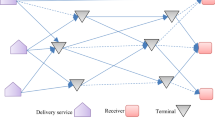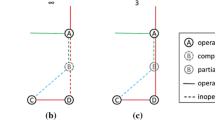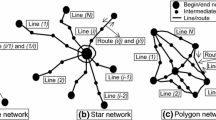Abstract
Railway network is an integral part of the economy of many countries. Identifying critical network elements can help network executives to take appropriate preventive actions before the occurrence of catastrophic disruptions or to add necessary redundancy to enhance the resilience of the rail network. The criticality of an element or a link is measured by calculating the increased cost or delay when that element is disrupted. In this paper, we proposed a framework for assessing the vulnerability of the freight rail networks by introducing two bi-level models. The first model determines those critical links which have the greatest impact on the routing cost when interdicted, and the next one takes the cost of rescheduling into account, in addition to that of routing, over all origins and destinations. Rerouting effects are already well-captured by existing alternative measures, but this study allows capturing the ramifications of rescheduling measures. The trains are scheduled by a time–space framework considering customer demand, track and station capacities, and time planning horizon. To overcome the difficulty of solving bi-level models, they are converted to single level models. To verify the models and the proposed approach, we considered a case study focused on three disruption scenarios for the railway network of Iran. The accuracy of the obtained results indicates the effectiveness of the proposed methodology. In addition, our method has a very short computational time in comparison with the network scan method (a full enumeration approach).













Similar content being viewed by others
References
Ahuja, R.K., Cunha, C.B., Şahin, G.: Network models in railroad planning and scheduling. In: Emerging Theory, Methods, and Applications, INFORMS, pp. 54–101 (2005)
Assad, A.A.: Models for rail transportation. Transp. Res. Part A Gen. 14(3), 205–220 (1980)
Berdica, K.: An introduction to road vulnerability: what has beendone, is done and should be done. Transp. Policy 9, 117–127 (2002)
Burdett, R., Kozan, E.: Determining operations affected by delay in predictive train timetables. Comput. Oper. Res. 41, 150–166 (2014)
Cats, O., Jenelius, E.: Beyond a complete failure: the impact of partial capacity degradation on public transport network vulnerability. Transp. B Transp. Dyn., 1–20 (2016). doi:10.1080/21680566.2016.1267596
Dehghani, M.S., Flintsch, G., McNeil, S.: Impact of road conditions and disruption uncertainties on network vulnerability. J. Infrastruct. Syst. 20(3), 04014015 (2014)
Derrible, S., Kennedy, C.: The complexity and robustness of metro networks. Physica A 389(17), 3678–3691 (2010)
Gedik, R., Medal, H., Rainwater, C., Pohl, E.A., Mason, S.J.: Vulnerability assessment and re-routing of freight trains under disruptions: a coal supply chain network application. Transp. Res. Part E Logist. Transp. Rev. 71, 45–57 (2014)
Jenelius, E., Mattsson, L.-G.: Road network vulnerability analysis of area-covering disruptions: a grid-based approach with case study. Transp. Res. Part A Policy Pract. 46(5), 746–760 (2012)
Jenelius, E., Petersen, T., Mattsson, L.-G.: Importance and exposure in road network vulnerability analysis. Transp. Res. Part A Policy Pract. 40(7), 537–560 (2006)
Khaled, A.A., Jin, M., Clarke, D.B., Hoque, M.A.: Train design and routing optimization for evaluating criticality of freight railroad infrastructures. Transp. Res. Part B Methodol. 71, 71–84 (2015)
Lawley, M., et al.: A time–space scheduling model for optimizing recurring bulk railcar deliveries. Transp. Res. Part B 42, 438–454 (2008)
Nemani, A.K., Ahuja, R.K.: OR models in freight railroad industry. In: Wiley Encyclopedia of Operations Research and Management Science (2011). doi:10.1002/9780470400531.eorms0622
Peterson, S.K., Church, R.L.: A framework for modeling rail transport vulnerability. Growth Change 39(24), 617–641 (2008)
RAI: Year Book of Railway, Overview report. In: Bureau of Transportation Statistics–Department of Transportation, Iran (2014)
Rodríguez-Núñez, E., García-Palomares, J.C.: Measuring the vulnerability of public transport networks. J. Transp. Geogr. 35, 50–63 (2014)
Scott, D.M., Novak, D.C., Aultman-Hall, L., Guo, F.: Network robustness index: a new method for identifying critical links and evaluating the performance of transportation networks. J. Transp. Geogr. 14(3), 215–227 (2006)
Sherali, H.D., Suharko, A.B.: A tactical decision support system for empty railcar management. Transp. Sci. 32(4), 306–329 (1998)
Sherali, H.D., Tuncbilek, C.H.: Static and dynamic time-space strategic models and algorithms for multilevel rail-car fleet management. Manage. Sci. 43(2), 235–250 (1997)
Taylor, M.A.: Remoteness and accessibility in the vulnerability analysis of regional road networks. Transp. Res. Part A Policy Pract. 46(5), 761–771 (2012)
Taylor, M.A., Sekhar, S.V., D’Este, G.M.: Application of accessibility based methods for vulnerability analysis of strategic road networks. Netw. Spat. Econ. 6(3–4), 267–291 (2006)
Wang, Z., Chan, A.P., Yuan, J., Xia, B., Skitmore, M., Li, Q.: Recent advances in modeling the vulnerability of transportation networks. J. Infrastruct. Syst. 21(2), 06014002 (2014)
Williams, H.P.: Model building in mathematical programming. Wiley, New York (2013)
Zhang, Z., Li, X., Li, H.: A quantitative approach for assessing the critical nodal and linear elements of a railway infrastructure. Int. J. Crit. Infrastruct. Prot. 8, 3–15 (2015)
Acknowledgements
The author would like to thank the reviewers for their valuable comments and suggestions which helped to improve the paper. This research was supported by the Iran National Science Foundation (INSF), Project No. 94806427.
Author information
Authors and Affiliations
Corresponding author
Appendix: Mathematical proofs
Appendix: Mathematical proofs
Lemma 1
The optimal solutions of Problem 1 and Problem 2 are equal for a fixed \(y\).
Proof
According to Williams (2013), the optimal values of the decision variables of a linear programming problem with an integer right-hand side would be also integer, if the coefficient matrix (\(A\)) is totally unimodular. A sufficient condition for total unimodularity of a matrix can be defined as property P.
Property P: (from Williams 2013)
-
1.
Each element of \(A\) is 0, 1 or -1.
-
2.
In each column, at most two non-zero elements can appear.
-
3.
The rows can be partitioned into two subsets \(P_{1}\) and \(P_{2}\) such that
-
a.
if a column contains two non-zero elements of the same sign, one element is in each of the subsets;
-
b.
if a column contains two non-zero elements of opposite sign, both elements are in the same subset.
-
a.
Problem 2 is a linear programming model, and its coefficients’ matrix holds sufficient condition for total unimodularity that ensures that every basic feasible solution is automatically integer. According to LP theory, one optimal solution exists that is a basic feasible solution, therefore an optimal solution of Problem 2 is integer and satisfies constraint (1 g).\(\square\)
Theorem 1
The optimal objective function of Problem 3 is equal to the one of the bi-level model (1a)-(1 g).
Proof
It can be proved by contradiction, so suppose that the optimal objective functions are not equal.
Problem 3, according to its definition, is the dual of Problem 2, for any fixed value of \(y\). First, we denote \(y^{*}\) and \(z^{*}\) as the optimal values of \(y\), and the optimal value of the objective function in the bi-level model, respectively. Then, if we rewrite Problem 3 with a fixed value \(y^{*}\), its optimal objective function would be equal to the optimal objective value of Problem 2, and according to Lemma 1, is equal to \(z^{*}\). We also denote \(y^{**}\) and \(w^{*}\) as the optimal values of \(y\) and objective function in Problem 3, respectively. Since \(z^{*}\) is a feasible solution for problem 3, \(w^{*} \ge z^{*}\). Likewise, the bi-level model can be converted to problem 2 after fixing \(y\) at \(y^{**}\) and its optimal objective value would be \(w^{*}\). As this value, \(w^{*}\), is a feasible solution for the bi-level model, it would be less than the optimal value of its objective function, \(w^{*} \le z^{*}\). Comparing the last two inequalities, it is concluded that \(w^{*} = z^{*}\), the optimal objective values of the bi-level model and problem 3 are the same, completing the proof.\(\square\)
Linearization procedure
It should be noted that the objective function (2a) contains non-linear terms \(u_{ij}^{r} y_{ij}\) which can be linearized by substituting variable \(\bar{u}_{ij}^{r} = u_{ij} y_{ij}\) and applying constraint sets (8)-(11).
where \(M\) is a big number. Finally, the proposed primary model of vulnerability would be:
subject to (1b), (1f), (2b-2d) and (3a-3d)
Rights and permissions
About this article
Cite this article
Bababeik, M., Nasiri, M.M., Khademi, N. et al. Vulnerability evaluation of freight railway networks using a heuristic routing and scheduling optimization model. Transportation 46, 1143–1170 (2019). https://doi.org/10.1007/s11116-017-9815-x
Published:
Issue Date:
DOI: https://doi.org/10.1007/s11116-017-9815-x




